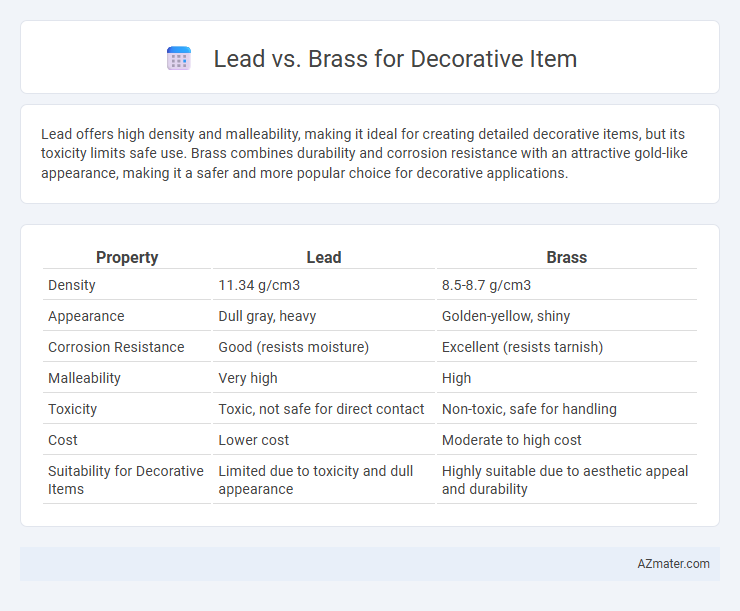Lead offers high density and malleability, making it ideal for creating detailed decorative items, but its toxicity limits safe use. Brass combines durability and corrosion resistance with an attractive gold-like appearance, making it a safer and more popular choice for decorative applications.
Table of Comparison
| Property | Lead | Brass |
|---|---|---|
| Density | 11.34 g/cm3 | 8.5-8.7 g/cm3 |
| Appearance | Dull gray, heavy | Golden-yellow, shiny |
| Corrosion Resistance | Good (resists moisture) | Excellent (resists tarnish) |
| Malleability | Very high | High |
| Toxicity | Toxic, not safe for direct contact | Non-toxic, safe for handling |
| Cost | Lower cost | Moderate to high cost |
| Suitability for Decorative Items | Limited due to toxicity and dull appearance | Highly suitable due to aesthetic appeal and durability |
Introduction to Lead and Brass in Decorative Items
Lead and brass are prominent materials in decorative items, each offering unique aesthetic and functional properties. Lead provides a dense, malleable base with a distinctive dull gray appearance, often used in intricate, hand-crafted designs and stained glass components. Brass, an alloy of copper and zinc, features high corrosion resistance and a warm golden hue, making it ideal for ornate fixtures, jewelry, and vintage-style decorations.
Chemical Composition and Physical Properties
Lead, primarily composed of the element Pb, exhibits high density (11.34 g/cm3) and low melting point (327.5degC), making it soft and malleable but prone to oxidation and toxicity concerns in decorative items. Brass, an alloy mainly of copper (Cu) and zinc (Zn), combines corrosion resistance with a higher melting point (900-940degC) and superior strength, providing durability and a golden-yellow aesthetic preferred for ornamental applications. Chemical stability and mechanical resilience distinguish brass as a safer, more enduring choice over lead for decorative purposes.
Visual Appeal: Color, Texture, and Finish
Brass offers a warm, golden-yellow hue with a smooth, polished texture that enhances the luxurious visual appeal of decorative items, creating a timeless and elegant finish. Lead typically presents a dull gray color with a matte, heavier texture that may appear less refined and vibrant than brass. The reflective qualities of brass allow for various finishes, such as antique or satin, making it more versatile and attractive for decorative purposes.
Durability and Longevity
Brass is significantly more durable and resistant to corrosion compared to lead, making it ideal for decorative items exposed to environmental elements. Lead tends to tarnish and deteriorate faster over time due to its softness and susceptibility to oxidation. Choosing brass ensures longer-lasting aesthetic appeal and structural integrity in decorative applications.
Workability and Craftsmanship
Lead offers superior malleability and ease of shaping, making it ideal for intricate decorative items requiring detailed craftsmanship. Brass, while harder to work with, provides greater durability and a polished finish that enhances aesthetic appeal. Craftsmen often choose brass for long-lasting pieces but prefer lead when intricate molding and fine detailing are paramount.
Safety and Health Considerations
Brass is generally safer for decorative items than lead due to its lower toxicity and non-toxic nature when properly sealed or coated. Lead poses significant health risks, including lead poisoning and neurological damage, especially if the item deteriorates or is ingested. For long-term safety, brass offers a more stable and health-conscious choice in decorative applications.
Environmental Impact and Sustainability
Brass, composed primarily of copper and zinc, is more environmentally sustainable than lead due to its recyclability and lower toxicity. Lead poses significant environmental hazards because of its high toxicity, contaminating soil and water, and posing risks to human health and wildlife. Choosing brass over lead for decorative items reduces environmental pollution and supports safer, more sustainable material use.
Maintenance and Cleaning Tips
Brass decorative items require regular polishing with a mixture of lemon juice and baking soda to prevent tarnish and maintain their bright, golden appearance. Lead items, being softer and more prone to scratches, should be cleaned gently with a damp cloth and mild soap to avoid surface damage, while avoiding harsh chemicals that can degrade the metal. Proper maintenance of both metals includes storing them in dry environments to minimize corrosion and prolong their decorative appeal.
Cost Comparison and Value
Lead is generally more affordable than brass, making it a cost-effective option for decorative items on a tight budget. Brass, while more expensive, offers superior durability and a visually appealing finish that enhances long-term value. The choice between lead and brass depends on balancing upfront cost savings with the benefits of longevity and aesthetic appeal.
Choosing the Right Metal for Your Decorative Needs
Brass offers superior corrosion resistance and a warm golden appearance, making it ideal for decorative items that require durability and aesthetic appeal. Lead, although malleable and dense, poses significant health risks due to its toxicity and is less suitable for items handled frequently or used indoors. Choosing brass ensures a safer, visually attractive, and long-lasting decorative piece that withstands environmental wear effectively.

Infographic: Lead vs Brass for Decorative Item
 azmater.com
azmater.com